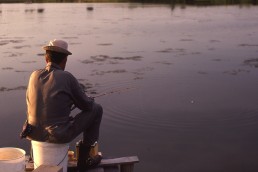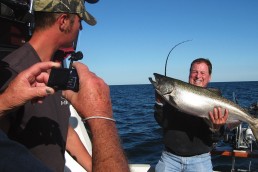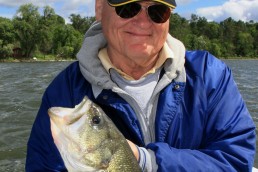Bank Fishing can be Productive
SHARE THIS POST
I read a stat once that said half the people in Ohio have been fishing at least once and that many of these same people fished twice a year or more. That’s a lot. Some of those are hardcore fishermen working out of glittery bass boats, trolling for muskies, hitting Lake Erie for walleyes or individuals searching smallmouths.
I suspect most just like to go fishing.
Drive around big lakes like Charles Mill, Knox, Pleasant Hill, Delaware and Clearfork, and anglers will be seen scattered along the banks. Many frequent city reservoirs, loaf along streams and rivers with two forked willow sticks to hold their rods or maybe a lawn chair and cooler, and have a good time. The kids play some and fish sometimes, while the adults talk and watch redwing blackbirds singing on cattail stems. Bank fishing—it’s a relaxing time way to spend an afternoon.
I’ve done a lot of this type of fishing myself and have talked over the years to hundreds of shoreline sitters. I’ve found they fall into two categories. One is the type who just wants to fish and doesn’t really want or need to catch that much. They need a few bluegills or a bullhead to justify their trip, but too much action means too much baiting, fishy smelling hands and swallowed hooks to be extracted—all interferes with their peaceful contemplation of the lapping waves and passing muskrats. The other category wants to enjoy a trip too, but want something to take home and fry up for supper like a tasty carp.
Consistent catches don’t happen for most because they simply find a spot and toss out a line, but there are ways to build a quality catch and find plenty of makings for a small skillet dinner.
Are you enjoying this post?
You can be among the first to get the latest info on where to go, what to use and how to use it!
First, take a minute to pick your spot. Most days, a section of lake that drops off quickly will outproduce a long mud flat in a lake’s shallow end. This is because fish can move quickly from deep water to shallower areas, and then back. If you’re fishing the bottom and using a standard two-snelled number 6 hook above a sinker, be sure to toss one well out from you and leave the other just 10-15 yards from shore. And if fishing with a partner, try to cover four different depths so you can quickly find out where the fish are holding. Bottom-anglers interested in anything that’ll bite should always use worms or nightcrawlers, while those interested mostly in channel cats or bullheads might try shrimp, slightly crushed minnows or prepared baits.
If you’re bobber fishing, concentrate your efforts within 50 feet of shore, moving in and out on each cast to locate fish, and add a sinker to your hook a few times to find the depths out there then adjust your floats to keep them within 1 foot of the bottom. You might use worms or waxworms on one hook and rig the second rod with a larger hook and a good-sized minnow impaled through the lips. Fish this one on the outer side of any weed beds because bass cruise the beds and a minnow looks good to them.
Wise bottom fishermen in a fair-sized lake might try chumming their spot. I met an angler just two years ago who’d brought a can of fish-based cat food, rolled it into golf ball-sized balls, and tossed the balls out in all directions. He had six nice channel cats drawn in by the scent. I’ve mentioned this more than once, but remember, move your rigs occasionally unless there’s wind to push the float. And, bottom fishermen should cast here, and then there. You might have a nice pod of keepers in a 10-foot-wide area, and then nothing—go elsewhere. Change casting directions too and sooner or later you’ll find that hot spot.
Stream and river fishermen have a different situation. Finned residents here like to lie up in the deepest pools for the day, so this is where they should be fished at using nightcrawlers, minnows and similar baits. If you’re there at dawn or dusk, fish just below any riffles or right on them, if they’re deep enough. Remember, foraging gamesters love riffles. You can chum here too, maybe with a can of oily jack mackerel attached to a line so it can be retrieved later. Toss the punctured can to the upper end of a pool and fish right below it. You might just be surprised at the rod bender who’ll suddenly take hold and make your day.
MWO
SHARE THIS POST
Did you enjoy this post?
You can be among the first to get the latest info on where to go, what to use and how to use it!
Richard Martin
Dick Martin is a retired biology teacher with a bachelor’s degree in Biology from Ohio U. and a master’s degree in Zoology from Ohio State U. He is a longtime member of Outdoor Writers of Ohio and Outdoor Writers Association of America. He and has written many outdoor articles on a variety of subjects.



